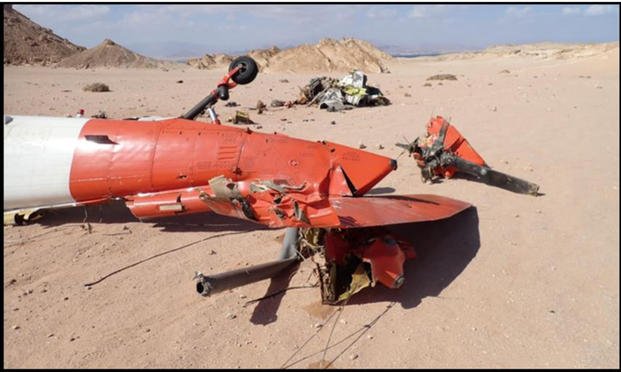An investigation into a horrific 2020 helicopter crash that killed seven troops, five of them U.S. soldiers, appears to indicate that a mechanical problem with the aircraft's stabilator preceded the disaster.
A heavily redacted investigation report, released to Military.com through a public records request, obscures many key details about the non-combat crash, its aftermath and actions the Army took in its wake. But it does describe warning signs that something had gone wrong, and the traumatic dive and impact that followed.
The crash occurred on Nov. 12, 2020, in the vicinity of Sharm el-Sheikh, Egypt, while a group of service members from an international coalition was conducting a routine training flight on a Sikorsky UH-60L Black Hawk. The troops aboard were supporting the Multinational Force and Observers, a group composed of 13 nations that has worked since 1981 to monitor the 1978 peace agreement between Israel and Egypt on the Sinai Peninsula.
Read Next: F-16 Pilot's Runway Death Forces Reckoning Over Tight Flight Hours, Training Gaps
The U.S. contributes the largest military contingent to the MFO, typically sending National Guard troops to the region on one-year rotations.
Killed in the crash were: Capt. Seth Vernon Vandekamp, 31, from Katy, Texas; Chief Warrant Officer 3 Dallas G. Garza, 34, from Fayetteville, North Carolina; Chief Warrant Officer 2 Marwan Sameh Ghabour, 27, from Marlborough, Massachusetts; Staff Sgt. Kyle Robert McKee, 35, from Painesville, Ohio; and Sgt. Jeremy Cain Sherman, 23, from Watseka, Illinois. One Czech and one French soldier also died in the crash; another U.S. service member was injured but survived.
The Nov. 12 flight had been a three-leg mission that began with a weekly reconnaissance operation, followed by a unit reenlistment flight and concluding with a resupply, according to the Army-led mishap investigation. During the resupply, the Black Hawk crew had planned to conduct a familiarization tour of the region for new arrivals to the mission, including a U.S. medical officer and the French and Czech service members. It also would contain a sling-load skill refresher training for Sherman, a crew chief, and serve as a check ride for Ghabour, the pilot. Overall, the day was assessed to be a low-risk operation.

The flight departed on schedule around 8:30 a.m. after several hours of standard workups, flight checks and crew brief, the investigation found. The reconnaissance mission was uneventful, as was the unit reenlistment ceremony at a designated landing zone. The Black Hawk then returned to its point of origin for refueling and reconfiguration for the sling-load resupply.
It was still mid-morning when the helicopter lifted off again, headed to a remote site on top of a mountain where the objective was "to conduct a sling load of expended supply material, packaged in a cargo net, and transport it to [a second remote site]." This task went according to plan. At the drop-off site, the helicopter placed its expended supplies on the ground and picked up a water bladder it would transfer back to the first remote site.
"After successfully inserting the water bladder, the aircraft executed a tactical departure to the north, following the descending terrain down from [the first remote site]," the mishap report reads. "The mishap aircraft continued to follow the descending terrain down to the base of the mountain and impacted the ground on level terrain at 10:46:09."
The crash took place at an extreme nose-down angle, with "tremendous force," the investigation states, splintering the helicopter and scattering the fuselage.
Remarkably, given the force of impact, the crash's lone survivor was found sitting upright amid the wreckage, the investigation states. The survivor was not identified, nor was the extent of his injuries specified. He was evacuated to Israel's Yoseftal Hospital, then sent to Germany and on to Walter Reed National Military Medical Center in Bethesda, Maryland, once his condition stabilized.
While pre-flight and post-crash evaluations did not show any defects with the helicopter, a recovered audio recording reveals that a crew member called out an anomaly with the stabilator, a small, movable horizontal flap on the rear of the aircraft that helps keep it level in flight.
"The evaluation of the flight data revealed that the stabilator remained in the down/hover mode when the aircraft transitioned into terrain flight mode descending the side of the mountain, which prevented the aircraft from pitching longitudinally," investigators found.
Although a probe of flight hours and maintenance records revealed no other anomalies or operational concerns, it appears the stabilator caused trouble several times over the course of the morning.
"The voice recording revealed that during the 2 hour flight sequence the horizontal stabilator failed multiple times at hover, on the ground, and was in the manual mode just prior to the accident," the document states.
While little else has been revealed about the crash and follow-on actions, images and descriptions of the crash scene underscore the violence of the impact. Parts of the aircraft were found as far as 455 feet from the initial impact point, and the force of the crash created a divot in the earth eight feet wide.
While the Black Hawk is a workhorse transport aircraft that is used by four major militaries and has flown for the U.S. Army since 1981, it does have a distant history of stabilator-related mishaps. In 1987, early in the Black Hawk's service, the Army temporarily banned pilots from high-speed, low-altitude flight in the aircraft following an incident in West Germany in which a helicopter plummeted 2,500 feet before pilots regained control. In recent years, however, there are no publicly available reports of systemic stabilator issues, and the Army has not announced any plans to limit Black Hawk flights in the wake of the Sinai crash.
-- Hope Hodge Seck can be reached at hope.seck@military.com. Follow her on Twitter at @HopeSeck.
Related: A 'Disturbing Pattern' of Deadly Army Black Hawk Crashes Has Lawmakers Asking Questions












